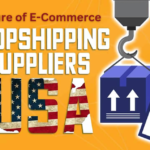Starting a dropshipping business is exciting. The global dropshipping market is expected to hit $372.47 billion by 2025 and $476.1 billion by 2026. To do well, you need to know the dropshipping model and use successful strategies. It’s easy to start with little money and sell products online.
When starting your dropshipping business, picking a profitable niche is key. Having a solid business plan is also crucial. The right tools and strategies can help you succeed. This article will guide you on how to start or grow your dropshipping business.

The success rate for dropshipping is between 10% to 20%. It takes careful planning to succeed. By using proven strategies and staying focused, you can overcome challenges. We’ll cover what makes a dropshipping business successful and how to start your journey.
Understanding the Dropshipping Model
The dropshipping model is a great way for almost anyone to start an e-commerce business. It lets entrepreneurs work with suppliers who handle the shipping and storage. This means you don’t have to worry about keeping inventory or managing it.
This approach is good because it has low startup costs and is low-risk. It’s a way to start a business without a lot of money upfront.
Recent data shows the global dropshipping eCommerce market is growing fast. It’s expected to hit 476 billion USD by 2026. This is a huge jump from 2020, showing how popular online shopping and dropshipping are becoming.
What Is Dropshipping?
Dropshipping is a way to start an online store without keeping any products in stock. You work with suppliers who take care of shipping and handling. This model is great because it’s easy to start, has low costs, and lets you sell many different products.
How It Differs from Traditional Retail
Dropshipping is different from traditional retail because you don’t need to store or manage inventory. This means you don’t have to worry about buying too much or too little. It also lets you sell more products without having to keep them all in stock.
Advantages of Dropshipping
Dropshipping has many benefits. It’s cheap to start, has low risks, and lets you sell lots of products. You also save money because you don’t have to buy and store inventory. With the right suppliers and strategy, you can improve how well you fulfill orders. This makes customers happy.
- Low startup costs
- Minimal risk
- Broad range of products
- Cost savings
- Improved order fulfillment metrics
Finding Your Niche in the Market
To succeed in dropshipping, finding a profitable niche is key. You need to pick an area with high demand and less competition. Tools like Google Trends help spot popular products and market trends.
When picking a niche, think about your target audience and market demand. For example, the global fashion industry is worth around $2.5 trillion. The toys market for kids is also booming, expected to hit $28 billion by 2025. Footwear is another big market, set to exceed $500 billion by 2030.
Google Trends and Minea are great tools for finding the right products. Researching competitors can also give you insights. Using a dropshipping platform means you don’t handle inventory or shipping, saving costs and boosting profits.
- Fashion and apparel
- Toys and games
- Home and garden
- Electronics and gadgets
Choosing the right niche and tools is crucial for success in dropshipping. Remember, success depends on picking the right products and suppliers. So, focus on niche selection and market research.
Choosing Reliable Suppliers
Choosing the right dropshipping suppliers is key to a successful business. They offer quality products, great customer service, and fast shipping. Tools like the Dropshipping.com supplier directory help find reliable suppliers. It shows information on products, prices, and shipping.
When picking suppliers, look for good prices, quick delivery, and clear communication. Sites like SaleHoo, Worldwide Brands, and Doba have many products and work with trusted suppliers. It’s important to check product quality, shipping times, and customer support.
Good relationships with suppliers are crucial for success. Keep communication open, give feedback, and solve problems quickly. Following these tips helps build strong supplier relationships, leading to better deals and growth.
- SaleHoo: offers access to over 8,000 verified suppliers and 2.5 million products
- Worldwide Brands: features a directory with over 16 million products from verified suppliers
- Doba: integrates with over 160 suppliers, allowing for streamlined management of multiple products
By picking reliable suppliers and using smart strategies, entrepreneurs can grow a successful online business.
Setting Up Your Online Store
To start a successful online store, you need a reliable e-commerce platform. It should have customizable features and work well with dropshipping apps. Shopify is a top pick for its easy use, flexibility, and smooth app integration.
Popular platforms for online stores include Shopify, Squarespace, and WooCommerce. They offer tools and features to help manage your store. When picking a platform, think about customization, payment options, and dropshipping support.
Here are important features for your online store:
- Customizable templates and design options
- Seamless integration with dropshipping apps and tools
- Excellent customer support and resources
- Secure payment gateways and transaction processing
Choosing the right platform and setting up your store with the right tools is key. This way, you can focus on marketing and growing your business. With the right tools, running your online store becomes easier.
| E-commerce Platform | Features | Pricing |
|---|---|---|
| Shopify | Customizable templates, dropshipping integration, secure payment gateways | Basic: $29/month, Standard: $79/month, Advanced: $299/month |
| Squarespace | Modern templates, basic e-commerce capabilities, limited customization options | Personal: $14/month, Business: $23/month, Basic Commerce: $27/month |
| WooCommerce | Free e-commerce plugin for WordPress, customizable, secure payment gateways | Free, with optional paid extensions and themes |
Crafting a Winning Business Plan
To start a successful dropshipping business, you need a solid business plan. A business plan is like a roadmap for your business. It guides you from the start to growth. It includes market research, financial plans, and marketing strategies.
When making a business plan, focus on market research, financial projections, and marketing. Market research helps you know your audience. Financial projections let you plan for costs and income. Marketing strategies are key to selling your products and getting customers.
Key Components of a Business Plan
- Market research: Understand your target audience and their needs
- Financial projections: Anticipate expenses and revenue
- Marketing strategies: Promote your products and attract customers
By following these tips and adding successful strategies to your plan, you can boost your chances of success. Set achievable goals and keep track of your progress. This will help you stay on track and reach your business goals.
Marketing Strategies for Dropshipping
Marketing is key for a dropshipping business to succeed. With more people shopping online, there are many ways to reach customers. Dropshipping lets you promote products without keeping any stock. Social media is a big help, with sites like Facebook and Instagram having lots of users.
Creating interesting content is also vital. This can be blog posts, videos, or social media updates. It helps attract and keep an audience interested. Email marketing is another strong tool for keeping in touch with customers and sharing special offers.
There are many tools to help with these strategies. For example, scheduling tools for social media make posting easier. Email marketing software helps send out targeted messages. Using these tools can boost your online presence, increase sales, and build a loyal customer base.
| Marketing Strategy | Benefits |
|---|---|
| Social Media Marketing | Increased brand awareness, targeted advertising |
| Content Marketing | Establishes authority, drives organic traffic |
| Email Marketing | Nurtures customer relationships, promotes new arrivals |
Optimizing Your Product Listings
When selling dropshipping products, it’s key to have great product listings. This means writing catchy descriptions, using top-notch images, and setting smart prices. These steps help boost sales and conversions. Studies show that products with good reviews and quality images sell better.
A top product listing has a clear title, under 200 characters, as Amazon allows. The title should be detailed and include important keywords. Also, using high-quality images can increase sales by up to 30%. Amazon lets you add up to 9 images, helping to show products from all sides.
Good pricing is also vital for sales. Tools like AlphaRank help improve SEO and visibility. Long-tail keywords attract more specific customers, which can lead to a 30% increase in targeted traffic. By optimizing listings, entrepreneurs can succeed in the dropshipping world.
Some important stats for product listings include:
- Optimized titles can make products 20% more visible
- Quality images can raise conversion rates by up to 30%
- Bullet points in listings can increase conversion by 50%
- Using relevant keywords in descriptions boosts SEO rankings
Fulfilling Orders Efficiently
Efficient order fulfillment is key for a dropshipping business to succeed. It means knowing the process well and using tech to make things smoother. In 2020, returns cost retailers about $428 billion, showing how crucial it is to get orders right and on time.
Tools like automated picking can cut down on mistakes. Good inventory management also helps avoid stockouts and keeps costs down. Using aids like pick-to-light or voice systems can make picking faster and more accurate.
Strategies for Efficient Order Fulfillment
Here are some ways to improve order fulfillment:
- Automated storage and retrieval systems (AS/RS) make inventory handling faster and more efficient.
- Batch picking for slow items can make the whole process more efficient.
- Keep fast items close to shipping areas to save time.
By using these methods, dropshipping businesses can better serve their customers. This leads to happier customers, more loyalty, and growth for the business.
Companies like Zendrop, Shopify Fulfillment Network, and Fulfillment by Amazon offer help with order fulfillment. They handle storage, packaging, and shipping. This lets dropshipping businesses focus on marketing and sales, ensuring orders are fulfilled correctly and on time.
| Company | Services | Pricing |
|---|---|---|
| Zendrop | Order fulfillment, storage, packaging, shipping | Varies based on services |
| Shopify Fulfillment Network | Order fulfillment, storage, packaging, shipping | No upfront storage fees for the first six months |
| Fulfillment by Amazon | Order fulfillment, storage, packaging, shipping | $0.99 per item sold for the Individual Plan, $39.99 monthly fee for the Professional Plan |
Analyzing Performance Metrics
To succeed in a dropshipping business, it’s key to analyze performance metrics. This means tracking website traffic, sales data, and marketing performance. By doing this, entrepreneurs can spot areas for betterment and make smart decisions to boost profits.
Some important performance metrics to watch include:
- Conversion Rate: The percentage of website visitors who make a purchase.
- Average Order Value (AOV): The average amount spent per transaction.
- Customer Lifetime Value (CLV): The total revenue expected from a customer throughout their relationship.
Using tools like Google Analytics can help track performance and find areas for improvement. By making decisions based on data, entrepreneurs can improve their dropshipping business and increase profits.
By regularly checking performance metrics, entrepreneurs can fine-tune their strategies. This data-driven approach helps businesses stay ahead and achieve long-term success.
| Metric | Description |
|---|---|
| Conversion Rate | Percentage of website visitors who make a purchase |
| Average Order Value (AOV) | Average amount spent per transaction |
| Customer Lifetime Value (CLV) | Total revenue expected from a customer throughout their relationship |
Staying Compliant with Regulations
As a dropshipping business owner, it’s key to know the rules. This includes E-commerce laws, tax rules, and product safety. Not following these can lead to legal trouble and harm your business’s image.
Taxes are a big deal for dropshipping businesses. They must deal with sales taxes, which change by state. Keeping detailed financial records is important. This is because businesses must tell the IRS about their income, no matter their structure.
Product safety is also a big worry. Having good contracts with suppliers helps avoid problems. E-commerce business insurance, which covers product and general liability, is also vital for online sellers.
To stay on track, check Amazon’s seller policies often. Also, talk to legal and tax experts. This helps dropshipping businesses understand and follow the rules better, reducing risks.
Scaling Your Dropshipping Business
If you own a dropshipping business, you’re probably eager to grow. Scaling your business means finding new ways to sell more and make more money. This includes adding more products and reaching out to new markets. Using technology to automate tasks can make your business run smoother and faster.
To grow, consider these important steps:
- Expanding your product range to meet different customer needs
- Looking into new markets in Asia, Africa, and South America
- Using smart marketing to find new customers and boost your brand
By focusing on these areas, you can grow your dropshipping business. Keep up with the latest trends and what customers want. This will help your business stay ahead in the market.
With the right plan, you can take your dropshipping business to new heights. By exploring new markets and adding more products, you can make more money. This will help you succeed in the fast-paced world of online shopping.
| Strategy | Benefits |
|---|---|
| Expanding product range | Increased customer satisfaction, improved brand reputation |
| Exploring new market opportunities | Access to new customer bases, increased revenue potential |
| Implementing effective marketing strategies | Increased brand awareness, improved customer engagement |
Future Trends in Dropshipping
As thedropshipping
industry grows, new opportunities emerge. Shoppers now want easy online shopping and products that feel personal. To succeed, entrepreneurs must keep up with the latesttechnological
innovations.
The globaldropshipping
market is set to explode. It could hit $470.92 billion by 2025 and $3,479.1 billion by 2033. The Asia-Pacific region is expected to grow the fastest, with a CAGR of 37.7%. The North American market is also expected to grow fast, with a CAGR of 33.3%.
Shoppers are now looking for eco-friendly, natural, and organic products. Dropshippers who offer these items will find success. Niche areas like beauty, pet supplies, and sustainable home goods are becoming more popular.







